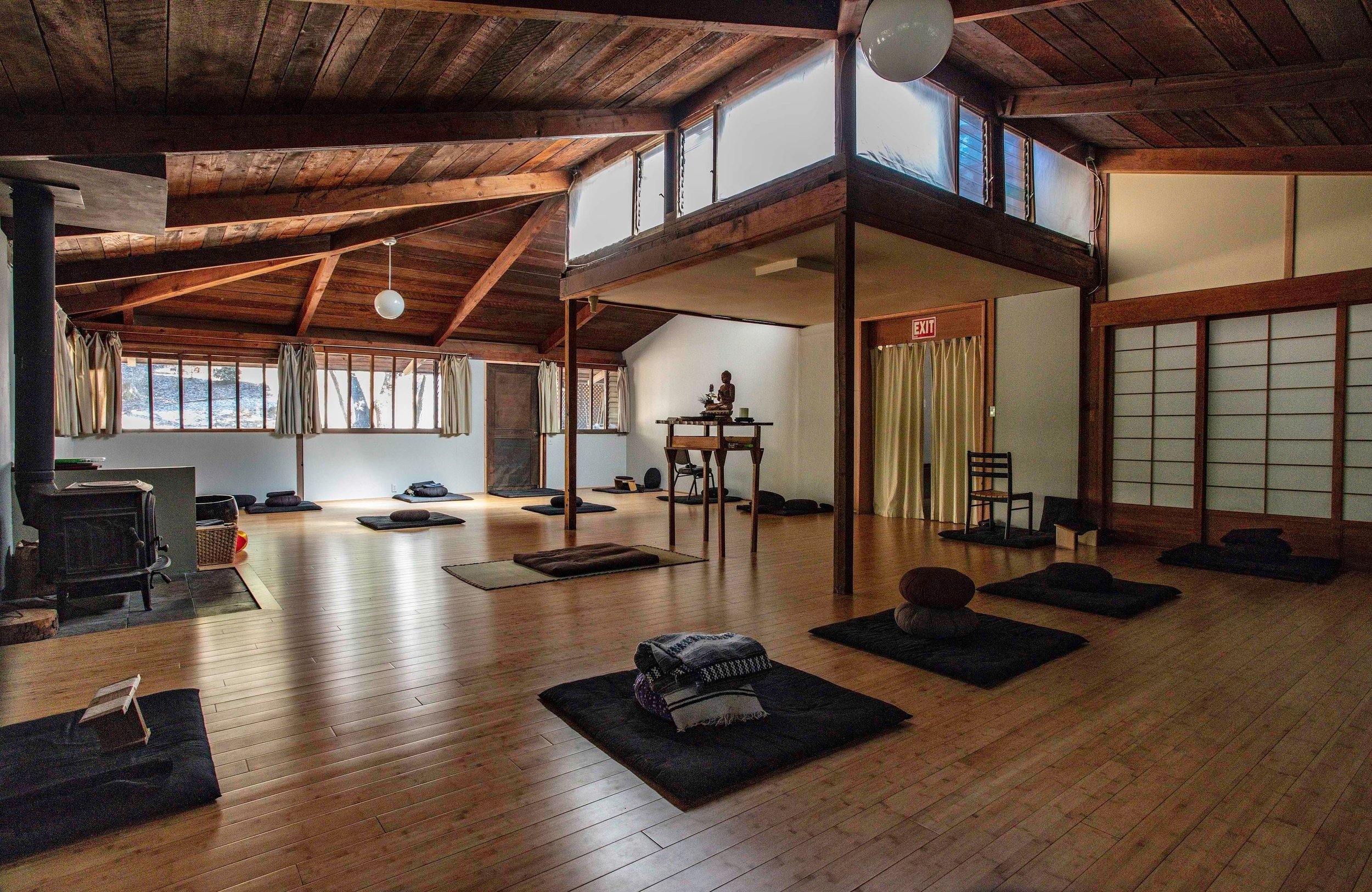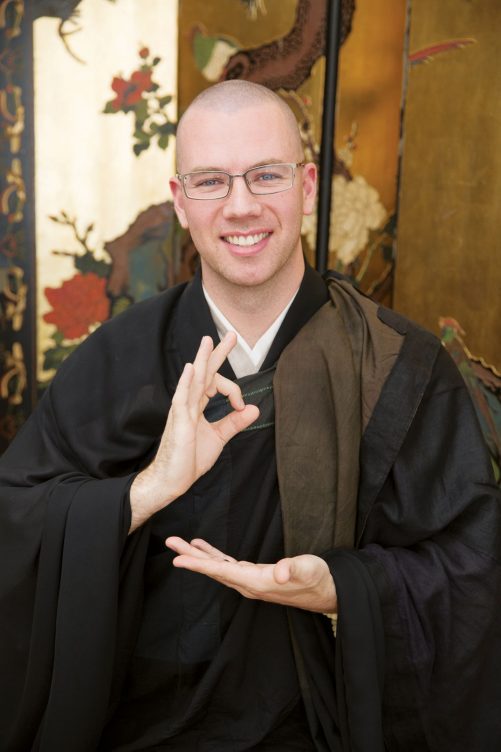This post is by sangha member, J. Parrish Lewis, originally posted on his blog Munky Mind on December 5, 2022
The exterior of Jikoji Zen Center’s Community Building on a rainy night. The night was cool and the soft glow inside the buildings were very inviting. The building that is the focus of this shot is where the kitchen, dining room, and library are. The path down the hill heads in the direction of the Zendo.
I went to sit.
After a little over 3 years of Zen practice being a major part of my life, I was invited by my teacher, Rev. Ōshin Jennings, founder and guiding teacher of No Barriers Zen, to attend part or all of the Rohatsu Sesshin at Jikoji Zen Center in the Santa Cruz Mountains above Saratoga.
I almost didn’t go, despite wanting to meet Ōshin in person. His guidance has been essential over the years, but we had only even met in video chats. I was too full of doubts, feeling that familiar sense of being an imposter despite my practice. But I signed up for what I could, Friday night through midday Sunday, with the full intent of going despite my feelings.
Last week a friend passed away, and I realized that I had missed the opportunity to spend time in person with this friend, who I also met online. So at that moment I realized I should never get in my own way of pursuing opportunities to meet people who are important to me, and to deepen my own practice at the same time.
By the time I got to where Jikoji is, it was beyond dark, and I was driving on that very narrow road, looking for the entry sign. GPS was no longer working due to the lack of a signal. In fact, I passed the entrance 4 times in my search, before finally seeing it. Meanwhile Ōshin had texted me, though I did not see it until I left, that a senior teacher was “coming up on his bicycle to the road with a light to guide you in.” Picture a Zen monk, biking in the darkness, ready to guide. Fortunately, he didn’t have to make his way up there, for I arrived just in time.
Meeting my teacher in person was a true pleasure, after all this time, along with Tess, a friend from our sangha who was both practicing and interpreting.
I had arrived just in time for an informal dinner of spaghetti and salad, and sat to talk with Ōshin and Tess. Well, rather, to pepper them with questions because the truth was, aside from meeting them, I basically knew we’d be meditating a lot.
That was an understatement. When I asked what time we’d begin the next morning, they said 5 am. “Good for us, bad for you!” they joked, since being from the East coast meant it’d feel like 8am to them. Then I saw the schedule. Cycles of 40-minute-long zazen sits, 10-minute-long kinhin walks flooded the schedule from 5:30am to around 9 at night, with only a few breaks including the mealtimes.
Within the hour we were already down in the large Zendo meditating. Shoes are not allowed in any of the buildings, so they’re left outside the door. When we entered the Zendo, I just copied what I saw. We bowed to the Buddha, found our seats, and sat. I used a chair for the weekend, rather than sit on the cushion, due to health issues with my legs. Everyone faced the wall, or for those of us in chairs, the windows, which were covered at night with drapes. The room was dimly lit with a candle.
The candle cast light on me, I cast a Buddha-like shadow on the wall.
I sat, practicing my practice, noticing everything that arose in my monkey mind and trying to let go of it. And most of weekend, my mind was busy. It is what it is. My legs ached, even sitting in a chair, so by the time we rose for kinhin, it was a welcome change. I noticed: I am suffering. And I know that suffering is caused by our attachment. In this case, I was more than a little attached to the idea of my legs (and my back) not being in pain. So I tried, sometimes succeeding, to accept it all.
After an introduction from Doug, one of the lead monks, in which he explained the week for participants, a small number of us received a crash course in Oryoki from Ōshin. Oryoki is a set of nesting bowls, utensils, and more, all used in a very intricate practice during mealtime. It is 100% a meditation. By the time I left, I had a better understanding of how to use the set, though imperfectly.
I also learned that the rest of the retreat, with some exceptions, would be a silent retreat. No talking. We kept the signing to a minimum as well.
By the time I had settled in my bunk bed in the men’s dorm, I was already exhausted from the day. It still took me until near midnight to fall asleep, and when I woke up at 4am, I realized I couldn’t go back to sleep or I might oversleep. So I got up at 4am.
Had a 5am coffee in the main building, enjoying the darkness and the rain outside.
Most of Saturday was spent repeating the cycle of zazen, kinhin, and oryoki during mealtimes. We did break away from the group for two hours to connect online with our No Barriers Zen Sangha for sits and a talk from a guest teacher.
During the day, they opened the curtains. Because I was in a chair, my view was of the forest. In front of me was a particular tree that, despite my not intending it, kept presenting itself as being full of dragon faces. Just the patterns of the leaves, really, and the way the light caught those leaves and the way the rain made it move. I couldn’t help but see dragons everywhere. My dragon tree. And, while interesting and enjoyable, I would argue: not the point. In a way it was a regular distraction, but at the same time I also felt very very present. The past and the future had fallen away from me for the most part. Meanwhile, my monkey mind chattered about, swinging from tree to tree in my mind. My legs ache. My feet hurt. My back hurts. The person next to me moved, did the bell sound? But also, an acceptance of this. This is it, Ōshin often says.
We may be a little nutty to do this in the first place. But it’s also worthwhile.
Image description: the interior of JIkoji’s zendo, filled with natural light and zabutons, also a central altar and wood burning fireplace
A note about mealtimes and Oryoki: Before coming to Jikoji, I would have imagined that meals were very drawn out, slow affairs in which we savor our food. But I actually felt rushed half the time, because you can’t leave anything in the bowls, and everything needs to be cleaned and dried and repackaged in a very precise way. I enjoyed this, though, even if I felt rushed. I enjoyed how we served each other DELICIOUS food, how the hand signals differed from ASL, how we paid respect to the mealtime and the meal itself as part of the practice.
“Persist With Affectionate Awareness” - One of many messages posted around Jikoji inside the buildings.
The last morning, I actually overslept, likely because I was still exhausted. But I got up before 6am, got ready, and joined in. After breakfast, we had about an hour or so of free time, so I walked the grounds. I studied the forest, which came alive with squirrels and blue jays and deer. I put my hands on mossy trees, and I stood on a small bridge over the creek. I noticed a raindrop hit the bridge, dazzling in the light, then watched it slowly absorb into the wet wood. Nearby, the deer drank the water in the creek, being deer.
Before leaving, more zazen, more kinhin, and a meaningful talk from Ōshin. Here we were in the zendo, a room full of mostly hearing people who aren’t involved with the Deaf community, listening to a Deaf monk’s talk. I left with my head still swimming with thoughts of practice, of morning stars, of acceptance, of the idea of getting out of my own way.
This was a profound experience, even though I could not stay the entire sesshin. As I write, it’s still going on, and will continue through the rest of the week. I got a taste of this, and I found it both difficult and very much a treasurable experience.
One day: I’ll attend the full week of sesshin, nutty as that seems to me.




















